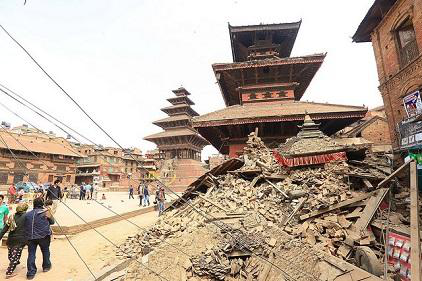
Several cultural heritage sites were damaged or destroyed in the 2015 earthquake in Nepal (Photo: UNDP)
By Andy McElroy
CANCUN, Mexico, 26 May 2017 – Cultural heritage and indigenous knowledge are key resources of community and national disaster resilience across the world.
However, much of this heritage and knowledge is being lost to both sudden and slow-onset disasters, weakening the resilience capacity of future generations.
To reverse the trend, a session at the 2017 Global Platform for Disaster Risk Reduction has made a series of recommendations to strengthen investment in such ‘human infrastructure’.
Adopt a holistic approach to cultural resilience.
Combine the best of science and traditional knowledge to preserve cultural heritage
Increase the recognition of the importance of protecting non-tangible heritage such as cultural diversity and traditional practice and knowledge as much as tangible heritage as sources of resilience
Prioritize the restoration of cultural heritage in post-disaster recovery
Increase the leadership and participation role of indigenous people in policymaking
Support the increased integration of traditional knowledge in the sustainable use of natural resources into modern social and economic life
Strengthen resource mobilization and investment to build capacity in preserving cultural heritage sites
The session heard that several initiatives have sought to build on indigenous and traditional local knowledge. The importance of cultural measures for building resilience to disasters is increasingly acknowledged. Nevertheless, the application of these tools and approaches needs to be more consistent.
The session was co-chaired India’s Minister of State for Home Affairs, Mr. Kiren Rijiju, who said culture is fundamental to the identity of a country and a community. He referenced the negative impact of the loss of heritage on Nepal as a result of its 2015 earthquake.
“When we lose heritage the loss is incalculable, of course we lose artifacts but we also lose much more. And recovery in the heritage sector is much more complex than recovery in other sectors. ‘Prevention is better than cure’ applies much more in this respect,” he said.
India is home to 35 UNESCO world heritage and 900 museums. It has taken significant steps to protect these sites from disaster. This includes the development of National Disaster Management Guidelines for Museums, which Minister Rijiju said India was happy to share with other countries.
In the document’s foreword, Indian Prime Minister Narendra Modi says: “These guidelines are in alignment with the Sendai Framework for Disaster Risk Reduction 2015-2030. I am sure this document will go a long way in establishing new benchmarks for safety and security of our museums. The guidelines are an integral step towards maximizing the potential of heritage in India.”
Other regions of the world have also taken action.